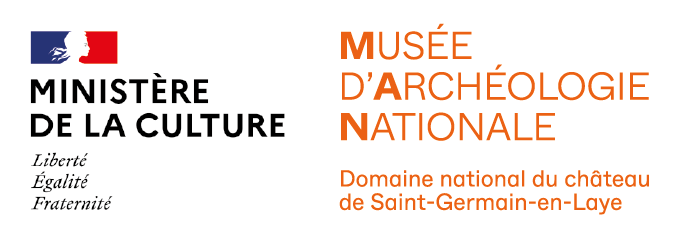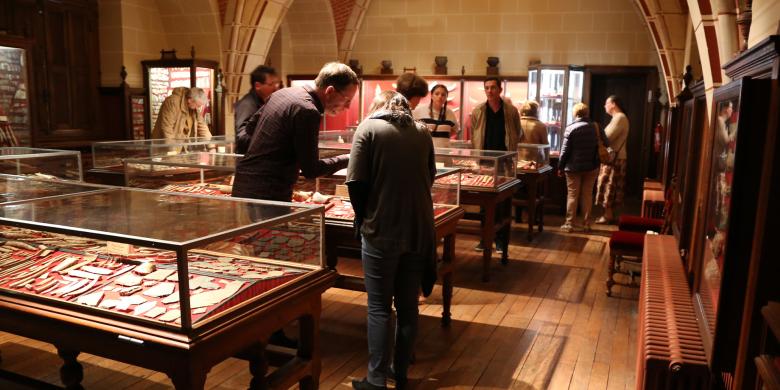The château, although in a very poor condition, was classified as an historic monument on 8 April 1863. Renovation works were entrusted to the architect Eugene Millet, a pupil of Viollet-le-Duc, and continued, under Laffolye and Daumet until 1907. The transformation of the château into a museum enabled this historic monument, in poor condition after all its changes of use, to be protected. The interior was just a maze of cells, corridors, false floors and partition walls, reducing the space in the rooms and damaging the floors with their weight. Outside, the château had been demolished in parts and was covered with a blackish plaster…
Millet put forward two restoration plans: to conserve the chateau with all its annexes, without any changes, limiting himself to consolidating the parts that were in a bad state or unfinished; or to get rid of these additions (the heavy corner pavilions) and restore the château to how it was under Francois I. This second project was chosen.
On 1 April 1865, the first of eight meetings of the Commission to organise the museum was held with the Comte de Nieuwerkerke, superintendant of the Beaux-Arts (similar to our Minister of Culture) as its president. This Commission brought together the great names in archaeology such as Alexandre Bertrand, Édouard Lartet, Félix de Saulcy and Jacques Boucher de Perthes; the chosen project was the work of Auguste Verchère de Reffye, Alexandre Bertrand and Claude Rossignol. The first director of the museum was Alexandre Bertrand. He adopted the chronological classification of objects, which, until that point, had normally been classified by subject.
The first rule of the museum, in 1866, specified that “the Saint Germain Museum aims to centralise all the documents relating to the history of the races that occupied Gaul from the earliest times up to the reign of Charlemagne, to classify these documents in a methodological order, to make them easy to study and available to the public, to publish them and to disseminate them for education purposes”.
The National Museum of Antiquities is therefore the first (and still today the only) museum devoted entirely to the archaeology of France. This also distinguishes it from the archaeological departments of the Louvre, which were developed at the same time.
The first seven rooms were inaugurated by Napoleon III on 12 May 1867 in the driving rain. This date had been chosen to coincide with the Universal Exhibition. Forty-four rooms were opened to the public in 1907.
The history of the Museum of National Antiquities is inextricably bound up with the development of French and European archaeology. Among the first collections to enter the museum were those of Jacques Boucher de Perthes from the area around Abbeville (Somme), which, towards the end of the 19th century, revealed the existence of a prehistoric race that had existed long before the Gauls.
Interest in French prehistory then grew rapidly thanks to the work of Gabriel de Mortillet, inventor of the current system of dating prehistory, who brought a large number of key archaeological series into the museum collections. The museum is also indebted to Edouard Piette for the majority of the pieces of Palaeolithic art now in the museum, displayed as they were in the early 20th century.
Gaulish archaeology began with the investigations of Félix de Saulcy, Alexandre Bertrand and Jacques-Gabriel Bulliot on the sites of the Gallic Wars, and in particular in Alesia and Bibracte. During the interwar period, Henri Hubert redesigned the way the museum’s collections were displayed, adding a whole section on comparative archaeology, based mainly on finds in the Far East.
The great archaeologists of the 20th century contributed to the enrichment and study of the collections, in particular Abbé Breuil, Louis Capitan, Henri and Jacques de Morgan, Abbé Cochet, Joseph Déchelette, and many others besides.
New collections continue to come into the Saint Germain museum. They originate from current research carried out in France or abroad (like the extraordinary series of objects from New Guinea, collected by Pierre Pétrequin) and from major rescue digs, like the exceptional objects from the Gaulish chariot graves discovered at Roissy Airport in 1995.
Although donations are one method of enriching the collections, the Museum also purchases objects from specialised galleries, individuals or public auctions. This was how the museum recently made two stunning acquisitions: a 4th century engraved glass cup, depicting Abraham’s sacrifice of Isaac, and Bronze Age gold hoard with two torcs and four bracelets.

